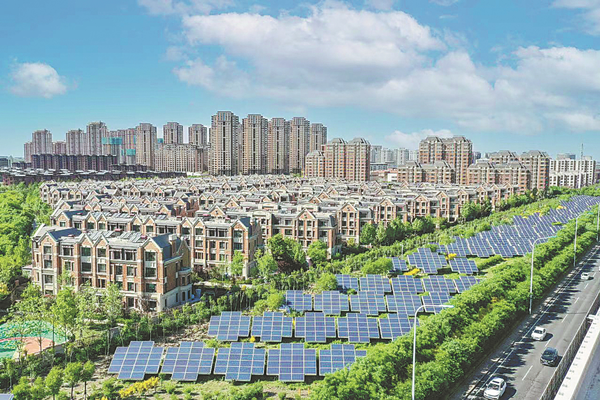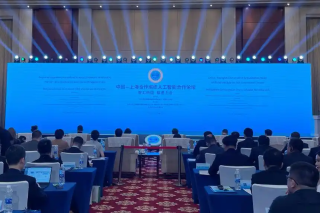Eco-friendly model city has taken root in Tianjin

Solar panels stand in a field next to a residential area at Sino-Singapore Tianjin Eco-City in June. All of the eco-city's buildings are green structures, employing technologies for natural ventilation, natural lighting and renewable energy systems, according to its developer. CHINA DAILY
Environmental protection, social harmony integrated as nation strives for carbon reduction goals
A decade ago, Zhou Bin, a project manager at an auto factory, found it difficult to meet other residents in the new city he called home.
"While there was construction all around, the streets themselves seemed quite empty then," he said.
But just as the famous movie line goes-"If you build it, they will come"-the construction buzz soon filled Sino-Singapore Tianjin Eco-City, which is in the northern China municipality of Tianjin, with a thriving population.
"It can be really bustling now, especially during peak hours with the busy roads," said Zhou, 38.
Zhou, an employee at a production facility for carmaker Toyota, has had a front-seat view to successful, sustainable development involving crucial government involvement, as part of the country's green priorities.
China aims to peak CO2 emissions before 2030 and achieve carbon neutrality before 2060.According to an action plan released last year, the country is set to increase the share of nonfossil energy consumption to about 25 percent by 2030 and lower CO2 emissions per unit of GDP by over 65 percent by 2030, compared with 2005 levels.
During this year's two sessions-the annual meetings of China's top legislative and political advisory bodies-President Xi Jinping, who is also general secretary of the Communist Party of China Central Committee, said that achieving carbon peak and carbon neutrality is a broad and profound initiative and a long-term task, which should be advanced with unswerving efforts and in a scientific and orderly manner.
Flagship project
Sino-Singapore Tianjin Eco-City-launched as a flagship bilateral cooperation project between the governments of China and Singapore following an April 2007 proposal to jointly build an eco-city in China-offers a pioneering model for growth that takes into account rapid urbanization and a rising emphasis on sustainable development worldwide.
China and Singapore have cooperated closely to drive the development of the eco-city, with the stated objective of consolidating best practices to transform what was once a saline-alkaline wasteland into a prosperous city that is ecologically friendly, socially harmonious and economically sustainable.
The 30-square-kilometer eco-city-which is in the coastal Binhai New Area, 45 kilometers east of downtown Tianjin and 20 km from the municipality's port-is planned as a modern, sustainable city that can support a population of 350,000.
The eco-city began "with the intention to share Singapore's experience in economic development that is consistent with environmental protection and social harmony", said Teo Eng Cheong, CEO of Sino-Singapore Tianjin Eco-City Investment & Development, or SSTEC, the master developer of the eco-city.
SSTEC is a 50-50 joint venture between a Chinese consortium led by Tianjin Infrastructure Construction& Investment Group and a Singapore consortium led by Keppel Group.
"I would say that over the years, Tianjin Eco-City has been very successful," said Teo, who listed some of the main factors behind the achievement.
First, the area originally was a wasteland with a lot of polluted water. The area's population was about 3,000 at that time, and through various engineering solutions, the land was rehabilitated and the water was cleaned, he said.
"Today we see beautiful lakes rather than polluted sewage ponds. That's the first thing we did-rehabilitating the land into something that is very livable and very environmentally friendly."
The second thing that the two countries did together in Tianjin was to take some of Singapore's urban planning lessons and apply them to the Chinese city, Teo said.
"In terms of planning our whole city, we developed it from scratch so that it's socially friendly and very livable. For instance, we make sure that there's a lot of greenery, a lot of parks. So residents here, when they go out, they can walk to a park very easily," he said.
"The design is such that you can walk for most of your daily essentials without having to take transportation, thereby reducing carbon emissions generated through transportation."
The third key factor in the city's success is that its planning and development objectives were very clear, so there is a whole series of key performance indicators that the city follows, Teo said.
"We insisted on 100 percent green buildings from the start, so this has also reduced carbon emissions. We also insist on tapping renewable energy resources to meet a certain percentage of our energy needs."
Teo said that from green buildings with waste recycling and renewable energy capabilities to easily accessible parks, "there are many indicators that the city adopts, and these have been revised over the years to ensure that they keep pace with prevailing international standards for eco-cities".
The eco-city has more than 120,000 permanent residents and 14,000 enterprises. In addition, there are 34 schools and kindergartens, with nearly 23,400 students, community centers that help integrate public welfare, and three major hospitals, including one for gynecology and obstetrics.
Other amenities include 38 urban parks and numerous scenic spots, such as a national maritime museum and an adventure theme park. The public transportation network includes a rail link between the eco-city and other areas of Tianjin.

Copyright © Tianjin Municipal Government.
All rights reserved. Presented by China Daily.
京ICP备13028878号-35



